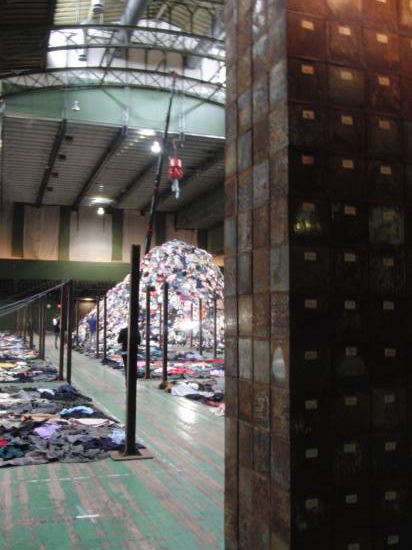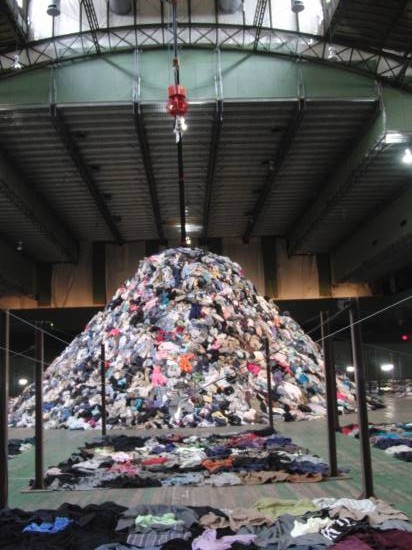Park Avenue Armory
643 Park Ave. at 67th St.
Tuesday – Sunday through June 13, 12 noon – 7:30 (Thursday 2:00 – 9:30) (open Memorial Day)
DAWN: June 2 at 6:00, June 3 at 7:30 (advance registration required)
Admission: $12 (children under twelve free)
347-463-5143
www.armoryonpark.org
www.mariangoodman.com
installation slideshow
French conceptual artist Christian Boltanski has filled the Park Ave. Armory’s Wade Thompson Drill Hall with thirty tons of clothing, laying them out in rectangular piles that evoke such tragedies as the Holocaust, the earthquake in Haiti, and the Katrina disaster, each shirt, jacket, dress, and pair of pants representing an anonymous person who might or might not be alive. The hooded sweatshirts are particularly eerie, especially when turned upside down. The rows and rows of clothing recall scenes from Alain Resnais’s Auschwitz-set NIGHT AND FOG documentary as well as news shots of people seeking refuge in the Superdome after the devastation of hurricane Katrina. In the center of the fifty-five-thousand-square-foot space, a sixty-foot-high crane scoops up and then drops individual items on top of a large mountain of clothing, like the children’s carnival game in which kids use a claw to pick up a toy, except in this case the crane is like the hand of God, deciding who will live and who will die. That feeling is amplified because of the location of the installation itself, in a military armory with walls containing plaques dedicated to men and women who died in the service of their country. Visitors can both wander through the rows to get a more personal view and also climb the stairs to see the massive piece as a whole, offering a different perspective.

Boltanski’s multifaceted, multimedia installation will feature special performances June 2-3 (photo by twi-ny/mdr)
When people first walk into the drill hall, they are met by a long, rusted, monolithic file cabinet with numbers on small drawers, a card catalog of the dead similar to Boltanski’s “The Reserve of Dead Swiss,” except in the latter he collected photographs of the dead instead of the random, out-of-sequence numbers displayed here. As Boltanski, who was born at the end of the Nazi occupation of France, notes in one of the display’s accompanying hand-outs, “The question is about destiny — why one person and not another?” But it’s not all about death; “No Man’s Land” also includes the sound of an enormous heartbeat echoing through the cavernous space, demonstrating that life goes on. Boltanski has been collecting heartbeats for years, creating Les Archives du Coeur, which he plans to maintain on Japan’s isolated Teshima Island; visitors to “No Man’s Land” can add the sound of their own heartbeat in a temporary “doctor’s office” in the outer hallway. It takes only a few minutes, and for $3 you can bring home a CD of your heartbeat. In another room, Heinz Peter Schwerfel’s documentary LES VIES POSSIBLES DE CHRISTIAN BOLTANSKI gives great insight into the life and career of the enigmatic artist. And the gift shop is called “The Book as Witness,” offering rare copies of Boltanski’s artist books, going back to the early 1970s. Although the installation is usually closed on Mondays, it will be open on Memorial Day, a fitting way to honor the holiday. In addition, composer Franck Krawczyk’s DAWN will take place June 2-3 within “No Man’s Land,” performed by the Argento Chamber Ensemble conducted by Michel Galante; there will be a public rehearsal on June 2 at 6:00, followed by the premiere on June 3 at 7:30. Although the special musical event is free with general admission, advance registration is required.
